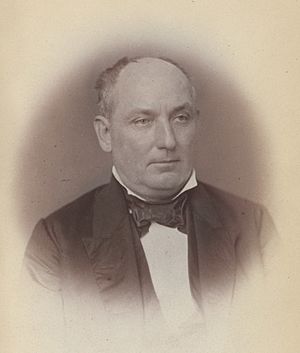James Henry Hammond facts for kids
Quick facts for kids
James Hammond
|
|
|---|---|
 |
|
| United States Senator from South Carolina |
|
| In office December 7, 1857 – November 11, 1860 |
|
| Preceded by | Andrew Butler |
| Succeeded by | Frederick A. Sawyer (1868) |
| 60th Governor of South Carolina | |
| In office December 8, 1842 – December 7, 1844 |
|
| Lieutenant | Isaac Witherspoon |
| Preceded by | John Peter Richardson II |
| Succeeded by | William Aiken Jr. |
| Member of the U.S. House of Representatives from South Carolina's 4th district |
|
| In office March 4, 1835 – February 26, 1836 |
|
| Preceded by | John Felder |
| Succeeded by | Franklin H. Elmore |
| Personal details | |
| Born |
James Henry Hammond
November 15, 1807 Newberry County, South Carolina, U.S. |
| Died | November 13, 1864 (aged 56) Beech Island, South Carolina, C.S. |
| Political party | Nullifier (before 1839) Democratic (1842–1864) |
| Spouse | Catherine Fitzsimmons |
| Education | University of South Carolina, Columbia (BA) |
James Henry Hammond (November 15, 1807 – November 13, 1864) was an American attorney, politician, and planter. He served as a United States representative from 1835 to 1836, the 60th Governor of South Carolina from 1842 to 1844, and a United States senator from 1857 to 1860. A slave owner, he is considered one of the strongest supporters of slavery in the years before the American Civil War.
Acquiring property through marriage, Hammond ultimately owned 22 square miles, several plantations and houses, and more than 300 enslaved people.
Biography
Born November 15, 1807, in Newberry County, South Carolina, to Elisha and Catherine Fox (Spann) Hammond, he graduated from South Carolina College in 1825, where he was a member of the Euphradian Society, and went on to teach school, write for a newspaper, and study law. He was admitted to the bar in 1828 and started a practice in Columbia, South Carolina. He established a newspaper there in support of nullification.
Hammond "secured his financial independence" by marrying Catherine Elizabeth Fitzsimmons, who was a shy, plain 17-year-old with a substantial dowry. He became a wealthy man through this marriage and entered the planter class. He ultimately owned 22 square miles (57 km2) of land, a number of plantation houses, and more than 300 enslaved persons.
After his marriage, he was elected to the United States House of Representatives as a member of the Nullifier Party, serving from 1835 until his resignation the next year due to ill health. After spending two years in Europe, he returned to South Carolina and engaged in agricultural pursuits; managing his large holdings took much of his time.
He was elected as governor of South Carolina, serving from 1842 to 1844. The legislature chose him for the United States Senate in 1857, following the death of Andrew P. Butler, and he served from 1857 until his resignation in 1860 in light of South Carolina's secession from the Union. Hammond died on November 13, 1864 (two days before his fifty-seventh birthday), at what is now the Redcliffe Plantation State Historic Site in Beech Island, South Carolina.
Pro-slavery
A Democrat, Hammond was perhaps best known during his lifetime as an outspoken defender of slavery and states' rights. He popularized the phrase that "Cotton is King" in his March 4, 1858, speech to the US Senate, saying:
"In all social systems there must be a class to do the menial duties, to perform the drudgery of life...It constitutes the very mudsill of society." He went on to utter the oft-repeated words "You dare not make war on cotton — no power on earth dares make war upon it. Cotton is king."
Hammond promoted Redcliffe, his plantation in Beech Island, South Carolina, as his ideal of the perfectly run plantation in his Plantation manual, 1857-58. It includes a wide range of material, with detailed rules regulating treatment of pregnant and nursing slaves (whom he allowed to nurse their infants for 12 months), old slaves no longer fit for heavy field work, together with rules about clothing, quarters, food, etc., in addition to livestock and crop management.
Legacy
Hammond School in Columbia, South Carolina, was named the James H. Hammond Academy when founded in 1966. It was one of a number of private schools known as segregation academies, founded to preserve racial segregation in schools. Although many of these segregation academies are now defunct, Hammond School continued to develop; after the 1970s, it expanded its admission policy, as federal law mandated, to be non-discriminatory. The school changed its name to reflect this.

